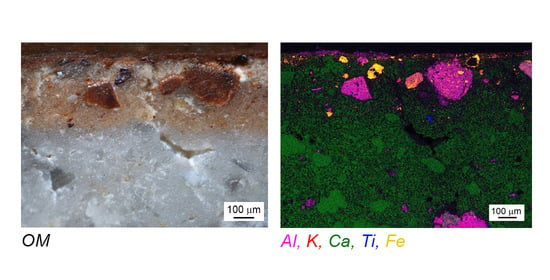The Irreplaceable Contribution of Cross Sections Investigation: Painted Plasters from the Sphinx Room (Domus Aurea, Rome)
Abstract
1. Introduction
- Obtaining new information concerning the painting technique of Domus Aurea, both observing the boundary between the plaster and the painted layers and studying the elemental distribution in the various layers, exploiting the unique potential of optical and electron microscopy in this field [33];
- Confirming and expanding the previous knowledge on Sphinx Room pigmenting agents, as obtained on samples as such [10].
2. Materials and Methods
- Optical microscopy (OM)
- Scanning Electron Microscopy—Energy Dispersive X-Ray Spectroscopy (SEM-EDS)
- Micro-Raman Spectroscopy
3. Results
3.1. Painting Technique
- I. More than one pigmented layer (BL and BR);
- II. One pigmented layer (YR, Y, B1, B2, G and R1).
3.2. Pigmenting Materials
4. Discussion
5. Conclusions
Supplementary Materials
Author Contributions
Funding
Data Availability Statement
Acknowledgments
Conflicts of Interest
References
- Elder, P.T. The Natural History; Taylor and Francis: London, UK, 1855. [Google Scholar]
- Ball, L.F. The Domus Aurea and the Roman Architectural Revolution; Cambridge University Press: Cambridge, UK, 2003. [Google Scholar]
- Albertano, P.; Luongo, L.; Grilli Caiola, M. Influence of different lights of mixed cultures of microalgae from ancient frescoes. Int. Biodeterior. 1991, 27, 27–38. [Google Scholar] [CrossRef]
- Giavarini, C. Domus Aurea: The conservation project. J. Cult. Herit. 2001, 2, 217–228. [Google Scholar] [CrossRef]
- Paradisi, A.; Sodo, A.; Artioli, D.; Botti, A.; Cavezzali, D.; Giovagnoli, A.; Polidoro, C.; Ricci, M.A. Domus aurea, the “Sala delle maschere”: Chemical and spectroscopic investigations on the fresco paintings. Archaeometry 2012, 54, 1060–1075. [Google Scholar] [CrossRef]
- Albero, S.; Giavarini, C.; Santarelli, M.L.; Vodret, A. CFD modeling for the conservation of the Gilded Vault Hall in the Domus Aurea. J. Cult. Herit. 2004, 5, 197–203. [Google Scholar] [CrossRef]
- Barone, P.M.; Mattei, E.; Lauro, S.E.; Pettinelli, E. Non-destructive technique to investigate an archaeological structure: A GPR survey in the Domus Aurea (Rome, Italy). In Proceedings of the XIII Internarional Conference on Ground Penetrating Radar, Lecce, Italy, 21–25 June 2010; pp. 1–4. [Google Scholar]
- Clementi, C.; Ciocan, V.; Vagnini, M.; Doherty, B.; Tabasso, M.L.; Conti, C.; Brunetti, B.G.; Miliani, C. Non-invasive and micro-destructive investigation of the Domus Aurea wall painting decorations. Anal. Bioanal. Chem. 2011, 401, 1815–1826. [Google Scholar] [CrossRef] [PubMed]
- Payne, E.; Booms, D. Analysis of pigment palettes as evidence for room status in Nero’s Golden House. Tech. Res. Bull. 2014, 8, 117–126. [Google Scholar]
- Caggiani, M.C.; Coccato, A.; Mazzoleni, P.; D’Alessio, A.; Russo, A.; Barone, G. Integrated analytical approach to unveil the secrets of the recently discovered “Sphinx Room”: A new piece of Domus Aurea puzzle—Accepted. Herit. Sci. 2020, 8, 1–21. [Google Scholar] [CrossRef]
- Bracci, S.; Bartolozzi, G. Wall paintings—Diagnostic and archaeometric studies. Phys. Sci. Rev. 2019, 4, 1–12. [Google Scholar] [CrossRef]
- Amadori, M.L.; Barcelli, S.; Poldi, G.; Ferrucci, F.; Andreotti, A.; Baraldi, P.; Colombini, M.P. Invasive and non-invasive analyses for knowledge and conservation of Roman wall paintings of the Villa of the Papyri in Herculaneum. Microchem. J. 2014, 118, 183–192. [Google Scholar] [CrossRef]
- Apostolaki, C.; Perdikatsis, V.; Repuskou, E.; Brecoulaki, H.; Lepinski, S. Analysis of Roman wall paintings from ancient Corinth/Greece. Adv. Miner. Resour. Manag. Environ. Geotechnol. Hania 2006, 729–734. [Google Scholar]
- Bakiler, M.; Kirmizi, B.; Ormanci Öztürk, Ö.; Boso Hanyali, Ö.; Dağ, E.; Çağlar, E.; Köroğlu, G. Material characterization of the Late Roman wall painting samples from Sinop Balatlar Church Complex in the black sea region of Turkey. Microchem. J. 2016, 126, 263–273. [Google Scholar] [CrossRef]
- Linn, R. Layered pigments and painting technology of the Roman wall paintings of Caesarea Maritima. J. Archaeol. Sci. Rep. 2017, 11, 774–781. [Google Scholar] [CrossRef]
- Weber, J.; Prochaska, W.; Zimmermann, N. Microscopic techniques to study Roman renders and mural paintings from various sites. Mater. Charact. 2009, 60, 586–593. [Google Scholar] [CrossRef]
- Ergenç, D.; La Russa, M.F.; Ruffolo, S.A.; Fort, R.; Sánchez Montes, A.L. Characterization of the wall paintings in La Casa de los Grifos of Roman city Complutum. Eur. Phys. J. Plus 2018, 133, 355. [Google Scholar] [CrossRef]
- Moormann, E.M. Roman Wall Painting. Encycl. Glob. Archaeol. 2018, 1–22. [Google Scholar] [CrossRef]
- Siddall, R. Not a day without a line drawn: Pigments and painting techniques of Roman Artists. InFocus Mag. Proc. R. Microsc. Soc. 2006, 2, 18–31. [Google Scholar] [CrossRef]
- Barone, G.; Mazzoleni, P.; Cecchini, A.; Russo, A. In situ Raman and pXRF spectroscopic study on the wall paintings of Etruscan Tarquinia tombs. Dyes Pigments 2018, 150, 390–403. [Google Scholar] [CrossRef]
- Vitruvius. Ten Books on Architecture; Cambridge University Press: New York, NY, USA, 2001. [Google Scholar]
- Birolo, L.; Tomeo, A.; Trifuoggi, M.; Auriemma, F.; Paduano, L.; Amoresano, A.; Vinciguerra, R.; de Rosa, C.; Ferrara, L.; Giarra, A.; et al. A hypothesis on different technological solutions for outdoor and indoor Roman wall paintings, Archaeol. Anthropol. Sci. 2017, 9, 591–602. [Google Scholar]
- De Vos, M. La bottega di pittori di via Castricio. In POMPEI 1748-1980 I Tempi Della Documentazione; Multigrafica Editrice: Rome, Italy, 1981. [Google Scholar]
- Mazzocchin, G.A.; Agnoli, F.; Mazzocchin, S.; Colpo, I. Analysis of pigments from Roman wall paintings found in Vicenza. Talanta 2003, 61, 565–572. [Google Scholar] [CrossRef]
- Baraldi, P.; Baraldi, C.; Curina, R.; Tassi, L.; Zannini, P. A micro-Raman archaeometric approach to Roman wall paintings. Vib. Spectrosc. 2007, 43, 420–426. [Google Scholar] [CrossRef]
- Mazzocchin, G.A.; Orsega, E.F.; Baraldi, P.; Zannini, P. Aragonite in roman wall paintings of the Viiia regio, aemilia, and Xa regio, venetia et histria. Ann. Chim. 2006, 96, 377–387. [Google Scholar] [CrossRef] [PubMed]
- Artioli, G.; Angelini, I. (Eds.) Scientific Methods and Cultural Heritage: An Introduction to the Application of Materials Science to Archaeometry and Conservation Science; Oxford University Press: Oxford, UK, 2010. [Google Scholar]
- Bersani, D.; Lottici, P.P. Raman spectroscopy of minerals and mineral pigments in archaeometry. J. Raman Spectrosc. 2016, 47, 499–530. [Google Scholar] [CrossRef]
- Janssens, K.; Van Grieken, R. (Eds.) Non-Destructive Microanalysis of Cultural Heritage Materials; Elsevier: Amsterdam, The Netherlands, 2004. [Google Scholar]
- Seccaroni, C.; Moioli, P.; Luchinat Acidini, C. Fluorescenza X: Prontuario per l’analisi XRF Portatile Applicata a Superfici Policrome; Nardini Editore: Firenze, Italy, 2002. [Google Scholar]
- Uda, M.; Demortier, G.; Nakai, I. (Eds.) X-rays for Archaeology; Springer: Dordrecht, The Netherlands, 2005. [Google Scholar]
- Vandenabeele, P.; Donais, M.K. Mobile Spectroscopic Instrumentation in Archaeometry Research. Appl. Spectrosc. 2016, 70, 27–41. [Google Scholar] [CrossRef] [PubMed]
- Piovesan, R. Archaeometrical Investigations on Mortars and Paintings at Pompeii and Experiments for the Determination of the Painting Technique; Univeristy of Padua: Padua, Italy, 2009. [Google Scholar]
- Piovesan, R.; Mazzoli, C.; Maritan, L.; Cornale, P. Fresco and lime-paint: An experimental study and objective criteria for distinguishing between these painting techniques. Archaeometry 2012, 54, 723–736. [Google Scholar] [CrossRef]
- Demir, S.; Şerifaki, K.; Böke, H. Execution technique and pigment characteristics of Byzantine wall paintings of Anaia Church in Western Anatolia. J. Archaeol. Sci. Rep. 2018, 17, 39–46. [Google Scholar] [CrossRef]
- Froment, F.; Tournié, A.; Colomban, P. Raman identification of natural red to yellow pigments: Ochre and iron-containing ores. J. Raman Spectrosc. 2008, 39, 560–568. [Google Scholar] [CrossRef]
- De Faria, D.L.A.; Venâncio Silva, S.; de Oliveira, M.T. Raman microspectroscopy of some iron oxides and oxyhydroxides. J. Raman Spectrosc. 1997, 28, 873–878. [Google Scholar] [CrossRef]
- Caggiani, M.C.; Barone, G.; de Ferri, L.; Laviano, R.; Mangone, A.; Mazzoleni, P. Raman and SEM-EDS insights into technological aspects of Medieval and Renaissance ceramics from Southern Italy. J. Raman Spectrosc. 2020. [Google Scholar] [CrossRef]
- Nieuwoudt, M.K.; Comins, J.D.; Cukrowski, I. The growth of the passive film on iron in 0.05 M NaOH studied in situ by Raman micro-spectroscopy and electrochemical polarisation. Part I: Near-resonance enhancement of the Raman spectra of iron oxide and oxyhydroxide compounds. J. Raman Spectrosc. 2011, 42, 1335–1339. [Google Scholar] [CrossRef]
- Andò, S.; Garzanti, E. Raman spectroscopy in heavy-mineral studies. Geol. Soc. Spec. Publ. 2014, 386, 395–412. [Google Scholar] [CrossRef]
- Bell, I.M.; Clark, R.J.H.; Gibbs, P.J. Raman spectroscopic library of natural and synthetic pigments (pre- ≈ 1850 AD), Spectrochim. Acta Part A Mol. Biomol. Spectrosc. 1997, 53, 2159–2179. [Google Scholar] [CrossRef]
- Hradil, D.; Píšková, A.; Hradilová, J.; Bezdička, P.; Lehrberger, G.; Gerzer, S. Mineralogy of bohemian green earth pigment and its microanalytical evidence in historical paintings. Archaeometry 2011, 53, 563–586. [Google Scholar] [CrossRef]
- Perez-Rodriguez, J.L.; de Haro M del, C.J.; Siguenza, B.; Martinez-Blanes, J.M. Green pigments of Roman mural paintings from Seville Alcazar. Appl. Clay Sci. 2015, 116–117, 211–219. [Google Scholar] [CrossRef]
- Moretto, L.M.; Orsega, E.F.; Mazzocchin, G.A. Spectroscopic methods for the analysis of celadonite and glauconite in Roman green wall paintings. J. Cult. Herit. 2011, 12, 384–391. [Google Scholar] [CrossRef]
- Coccato, A.; Mazzoleni, P.; Spinola, G.; Barone, G. Two centuries of painted plasters from the Lateran suburban villa (Rome): Investigating supply routes and manufacturing of pigments. J. Cult. Herit. 2020. submitted. [Google Scholar] [CrossRef]
- Pagès-Camagna, S.; Colinart, S.; Coupry, C. Fabrication processes of archaeological Egyptian blue and green pigments enlightened by raman microscopy and scanning electron microscopy. J. Raman Spectrosc. 1999, 30, 313–317. [Google Scholar] [CrossRef]
- Gunasekaran, S.; Anbalagan, G.; Pandi, S. Raman and infrared spectra of carbonates of calcite structure. J. Raman Spectrosc. 2006, 37, 892. [Google Scholar] [CrossRef]
- Grifa, C.; Cavassa, L.; De Bonis, A.; Germinario, C.; Guarino, V.; Izzo, F.; Kakoulli, I.; Langella, A.; Mercurio, M.; Morra, V.; et al. Beyond Vitruvius: New Insight in the Technology of Egyptian Blue and Green Frits. J. Am. Ceram. Soc. 2016, 99, 3467–3475. [Google Scholar] [CrossRef]
- Ingo, G.M.; Çilingiroǧlu, A.; Di Carlo, G.; Batmaz, A.; De Caro, T.; Riccucci, C.; Parisi, E.I.; Faraldi, F. Egyptian Blue cakes from the Ayanis fortress (Eastern Anatolia, Turkey): Micro-chemical and -structural investigations for the identification of manufacturing process and provenance. J. Archaeol. Sci. 2013, 40, 4283–4290. [Google Scholar] [CrossRef]
- Kostomitsopoulou Marketou, A.; Andriulo, F.; Steindal, C.; Handberg, S. Egyptian Blue Pellets from the First Century BCE Workshop of Kos (Greece): Microanalytical Investigation by Optical Microscopy, Scanning Electron Microscopy-X-ray Energy Dispersive Spectroscopy and Micro-Raman Spectroscopy. Minerals 2020, 10, 1063. [Google Scholar] [CrossRef]
- Mazzocchin, G.A.; Rudello, D.; Bragato, C.; Agnoli, F. A short note on Egyptian blue. J. Cult. Herit. 2004, 5, 129–133. [Google Scholar] [CrossRef]
- Baraldi, P.; Bonazzi, A.; Giordani, N.; Paccagnella, F.; Zannini, P. Analytical characterization of Roman plasters of the “Domus farini” in Modena. Archaeometry 2006, 48, 481–499. [Google Scholar] [CrossRef]
- Piovesan, R.; Siddall, R.; Mazzoli, C.; Nodari, L. The Temple of Venus (Pompeii): A study of the pigments and painting techniques. J. Archaeol. Sci. 2011, 38, 2633–2643. [Google Scholar] [CrossRef]
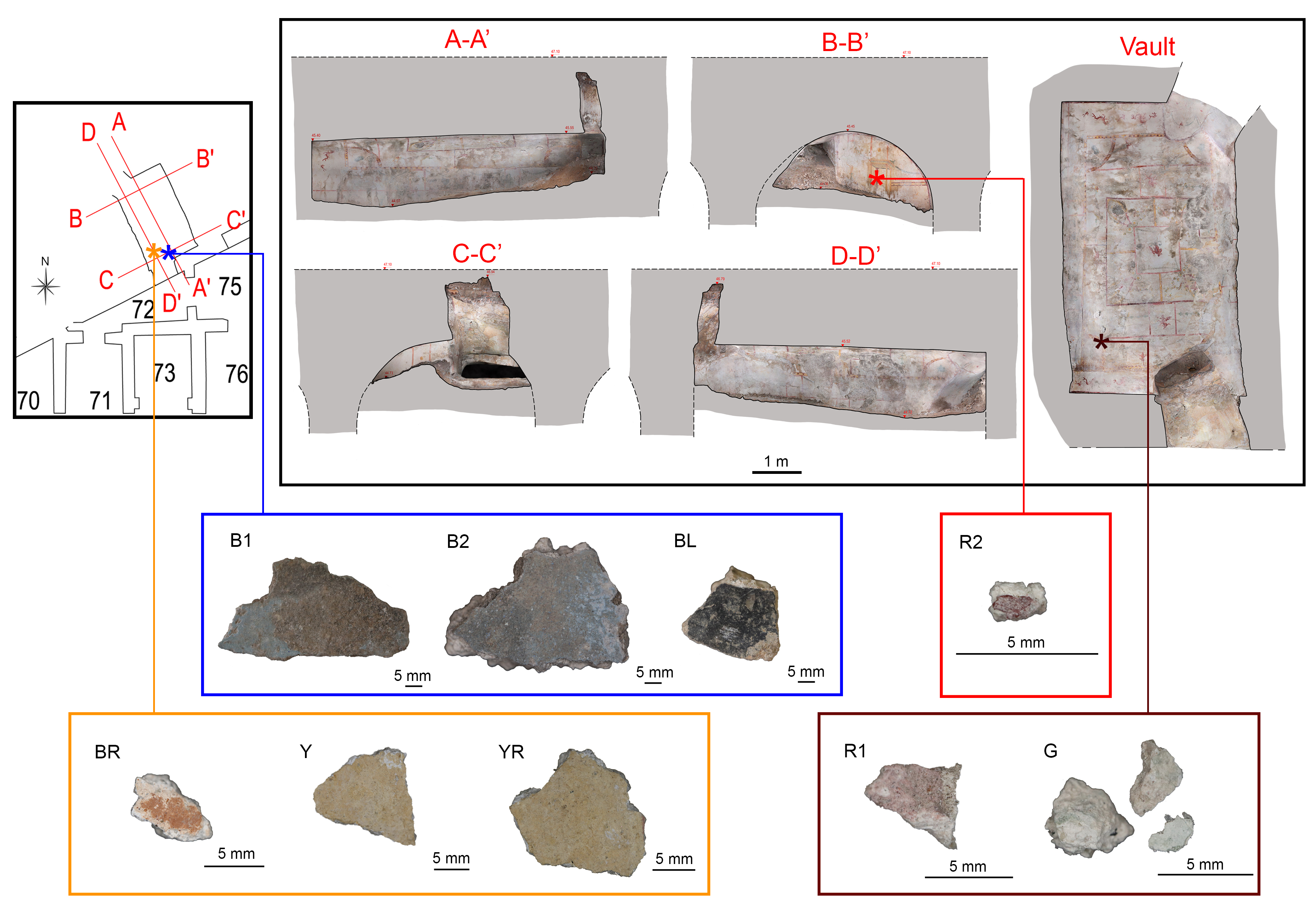
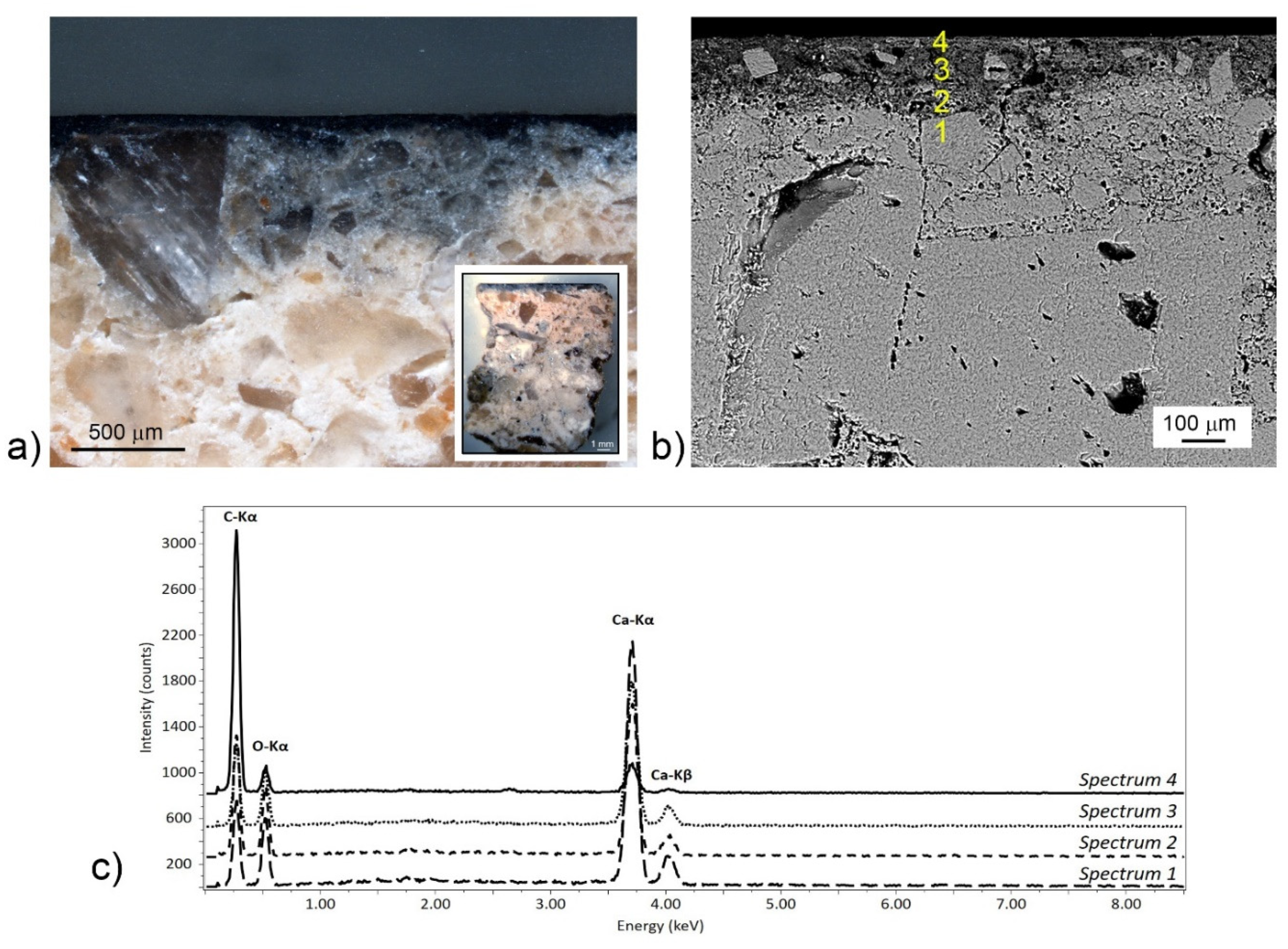

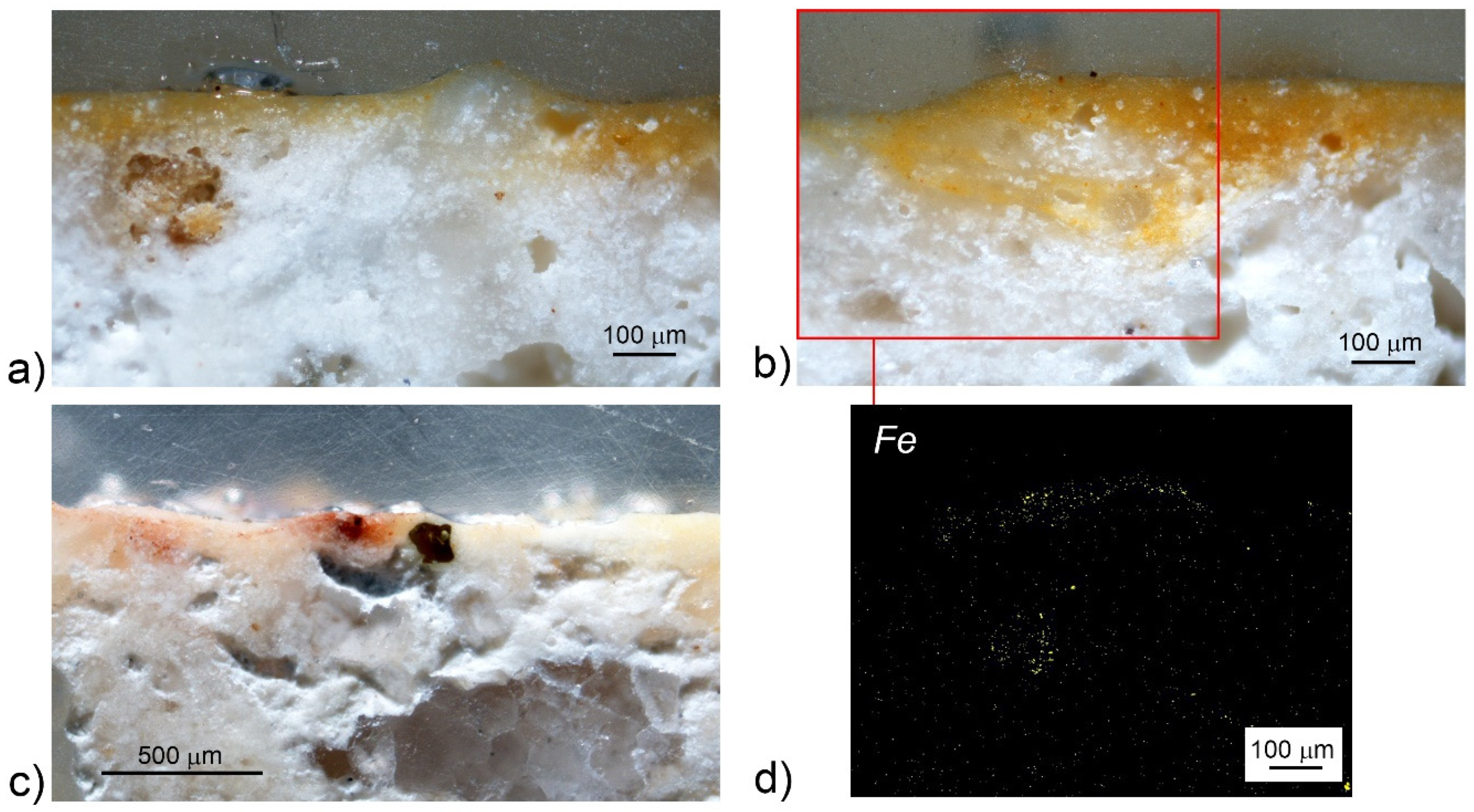
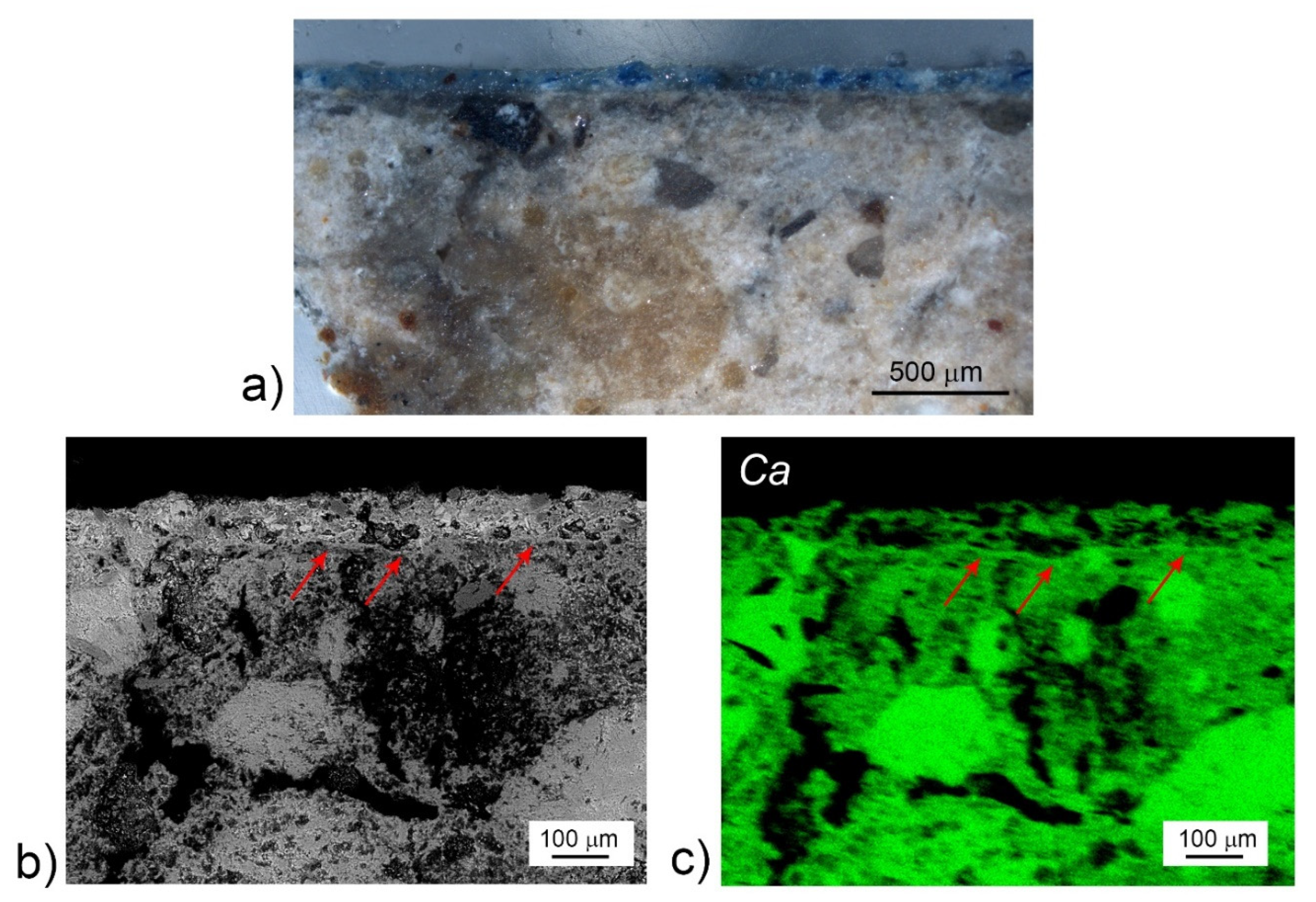



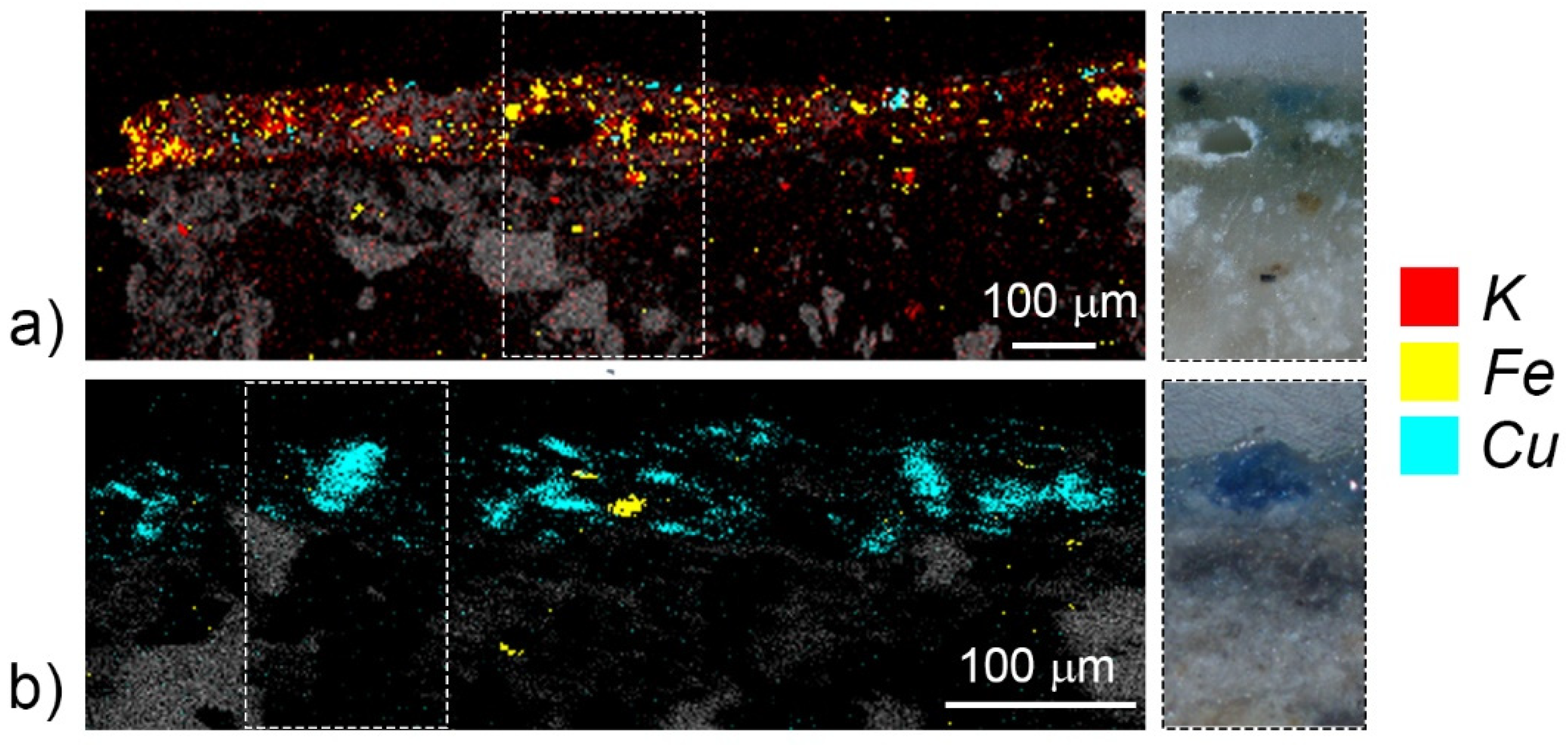
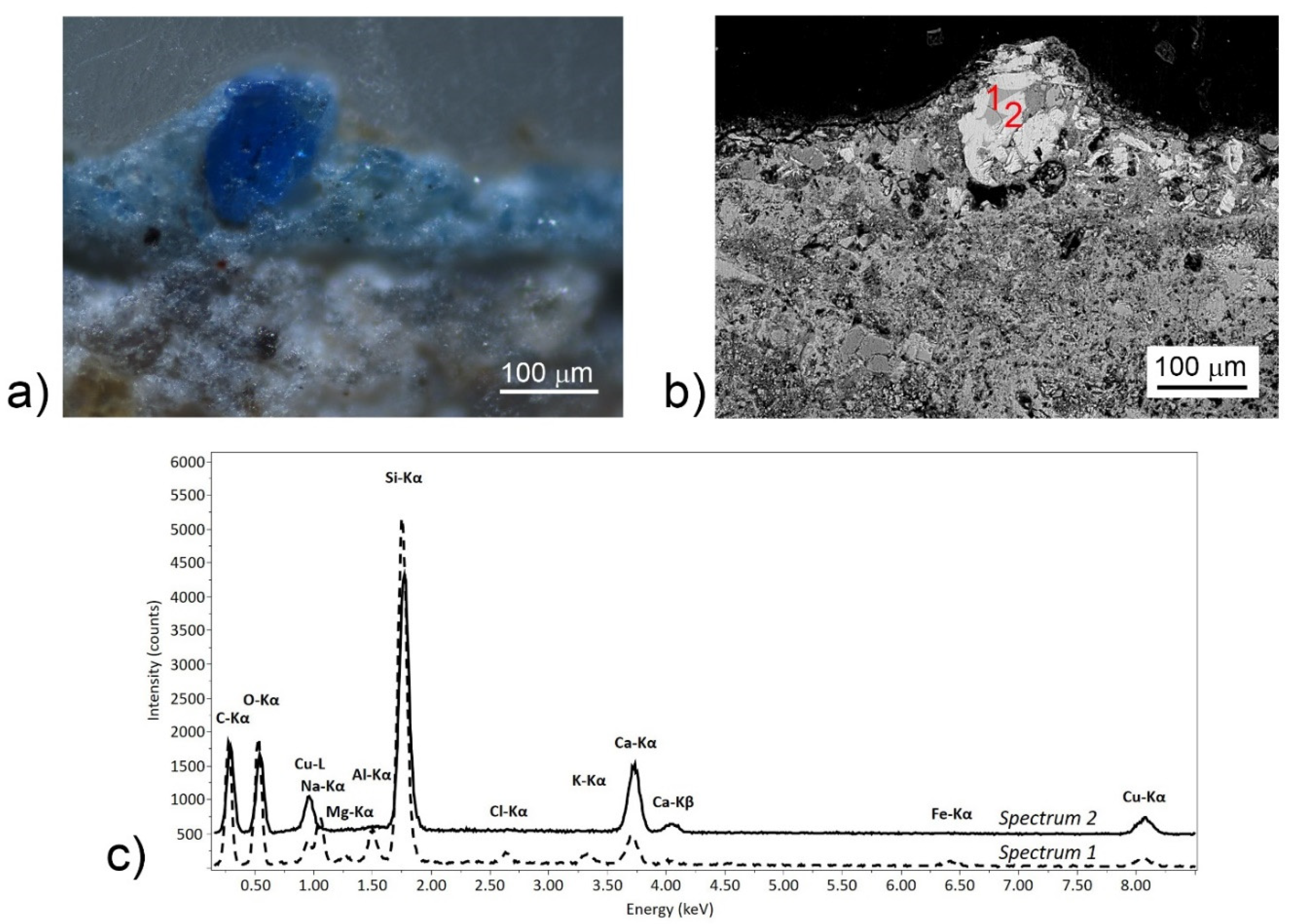
| Black | Red | Yellow | Blue | Green | White | Purple | Brown | |
|---|---|---|---|---|---|---|---|---|
| Corridor 92 [9] | Red ochres/Red lead, (Cinnabar on Pegasus) | Egyptian Blue | Green earth | |||||
| Room 119 [9] | Red ochres/Red lead, Cinnabar | Egyptian Blue | Cu-green | |||||
| Gilded vault [8] | Red ochres/Red lead, Cinnabar, Madder lake | Egyptian Blue | Green earth + Egyptian Blue | Egyptian Blue + Anthraquinonic lake | ||||
| Sala delle maschere [5] | Carbon black | Red ochres/Red lead | Egyptian Blue | Green earth | Calcite Lead white | Fe-based earth | ||
| Sphinx room [10] | Carbon black | Red ochres/Pb-compound | Yellow Ochres/Pb compound (also in orange) | Egyptian Blue + Gypsum | Green earth + Egyptian Blue? | Calcite Gypsum | Red ochres Magnetite |
Publisher’s Note: MDPI stays neutral with regard to jurisdictional claims in published maps and institutional affiliations. |
© 2020 by the authors. Licensee MDPI, Basel, Switzerland. This article is an open access article distributed under the terms and conditions of the Creative Commons Attribution (CC BY) license (http://creativecommons.org/licenses/by/4.0/).
Share and Cite
Coccato, A.; Caggiani, M.C.; Occhipinti, R.; Mazzoleni, P.; D’Alessio, A.; Russo, A.; Barone, G. The Irreplaceable Contribution of Cross Sections Investigation: Painted Plasters from the Sphinx Room (Domus Aurea, Rome). Minerals 2021, 11, 4. https://doi.org/10.3390/min11010004
Coccato A, Caggiani MC, Occhipinti R, Mazzoleni P, D’Alessio A, Russo A, Barone G. The Irreplaceable Contribution of Cross Sections Investigation: Painted Plasters from the Sphinx Room (Domus Aurea, Rome). Minerals. 2021; 11(1):4. https://doi.org/10.3390/min11010004
Chicago/Turabian StyleCoccato, Alessia, Maria Cristina Caggiani, Roberta Occhipinti, Paolo Mazzoleni, Alessandro D’Alessio, Alfonsina Russo, and Germana Barone. 2021. "The Irreplaceable Contribution of Cross Sections Investigation: Painted Plasters from the Sphinx Room (Domus Aurea, Rome)" Minerals 11, no. 1: 4. https://doi.org/10.3390/min11010004
APA StyleCoccato, A., Caggiani, M. C., Occhipinti, R., Mazzoleni, P., D’Alessio, A., Russo, A., & Barone, G. (2021). The Irreplaceable Contribution of Cross Sections Investigation: Painted Plasters from the Sphinx Room (Domus Aurea, Rome). Minerals, 11(1), 4. https://doi.org/10.3390/min11010004





